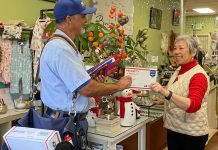
New landowners possess a particular kind of rose-colored glasses. Sign your name to a deed for acreage and suddenly, while touring that new piece of property, you see not necessarily what’s there but what might one day be. You see possibilities. You see potential.
Take, for example, one newly acquired piece of San Benito County, in the serene Anzar Hills near Aromas. A casual observer might see a sloping, dusty patch of scrub land with a southern exposure and a ridgetop stand of eucalyptus and Monterey pine. Pretty, but hardly extraordinary.
But through the eyes of the three young people who now call it home, this is a wonderland, or at least, it will soon be.
Welcome to Terra Cultura, a kind of experiment in conscientious living, to be built on the pillars of small-scale agriculture, the arts and community-building. To get a sense of what that means, let’s envision what this plot of land might look like in a year or two (or maybe three).
“The long-term vision is that you drive up and you’ll see right away a beautiful, blossoming pollinator garden with flowers and bees and hummingbirds,” said Rachel Wohlander, who co-owns the property with her sister Jessica Wohlander and Jessica’s husband Travis Hill.
You might be here to pick up your CSA box of freshly picked organic vegetables. With some time to kill, you wander beyond the farmstand toward the amphitheater where someone will be leading a workshop on greywater reuse and where later that evening a new theater piece will makes its local (and world) premiere. Beyond the theater space is a small box-like building that you learn is a recording studio where a band is playing. Out of one of the many yurts on the property steps a prominent Bay Area landscape painter, in the middle of a two-week residency and leading workshops.
“You could also wander down to the kitchen garden,” said Rachel Wohlander in the bright summer sun, squinting into the middle distance. “There would be mulch, plants, cover crops—not all this dust. And there would be trails throughout it.”
Maybe there’s an art opening or a musical performance, maybe you check out one of the residences. Maybe you bump into someone from town and chat. Maybe you park yourself at a table with a book and a cup of coffee.
“It would be a kind of bustling hub. That’s what we’re working toward. That’s the dream.”
The Wohlander sisters grew up in San Diego; Hill is originally from Burlingame, south of San Francisco. Jessica and Travis met while both were attending UC Santa Cruz, and for a while, all three were living in Brooklyn. All have a background in the performing arts.
Hill, 32, has been a musician since childhood and studied electronic music at UCSC. He has worked in the music tech field as an engineer and has also worked managing musicians’ rights on YouTube. He has released recordings as a singer/songwriter under the name Travis Shawn Hill.
Jessica, 32, has studied theater and worked with a guerilla theater company in New York, and she’s pursuing her interest in the visual arts. Rachel, 35, earned a master’s degree in performance from Brooklyn College, specializing in experimental and site-specific theater and technology. She’s also directed productions that she’s staged at Occupy Wall Street rallies as well as the Republican and Democratic national conventions. “I’m interested in pushing boundaries,” she said, “especially in theater that has something to say about social or political issues.”
All three partners have also worked in the realm of sustainability and have taken ideas and inspiration from organizations that have combined art and agriculture, such as the Occidental Arts and Ecology Center in Sonoma County. For more than 20 years, Occidental has been promoting ecological stewardship at its 80-acre research and education facility and, through arts programming, has been linking ecological and cultural diversity. Rachel Wohlander had a month-long residency at Art Farm Nebraska, which has attracted a wide range of writers, artists and performers. “They’ve found a really good balance between a place where you could hone your craft and get work done, and also to be social and have a very supportive arts community,” she said.
Inspired by these examples and empowered by a family inheritance, the Wohlanders and Hill set out to find a suitable plot of land to develop the dream of Terra Cultura (which is now a federal 501(c)(3) non-profit with a seven-member board of directors). In 2017, Hill went on a trek across Northern California, visiting about 70 prospective properties from the Gold Country to southern Monterey County.
“We saw a couple of decent things,” he said, “but we really just kept coming back to this area.”
The Anzar Hills property is not perfect, the Terra Culturistas admit. The property’s slope makes it a challenge to grow row crops. As a result, a number of terraced plots will be built. “We’re kind of crazy,” said Rachel. “But because land access is such an issue for young farmers, we thought it might be a cool model if we could show what you could do with nontraditional methods.”
Escrow on the site closed in January, and the trio moved onto the property in April. In August, they will begin their engagement with the Aromas arts community, inviting their first artist-in-residence to the area. The group has already established ties to the Aromas Hills Artisans, has been recruiting community volunteers to help in the task of improving the site, and is planning an open house Oct. 13 to launch the new Terra Cultura era.
The Wohlanders and Hill face another challenge in simply telling the community who they are. Because its focus is split between an arts center, community garden and educational center, Terra Cultura has few prominent models to point to.
“We like this idea of having many different entry points,” said Jessica Wohlander. “The dream is that someone comes to pick up their box of veggies and then realizes there’s an art opening and so they stay for the evening and hang out with the community. The idea is that no matter when you show up, something is going to be happening.”
“One of the things a lot of people are lacking is a cohesive community,” said Rachel Wohlander. “People are generally feeling quite alienated and isolated. In our experience, collaborative projects around art are really important in connecting people face to face and in a physical place.”
Added her sister, “We just want it to take on a life of its own.”
For more information on Terra Cultura, go to terracultura.org.









